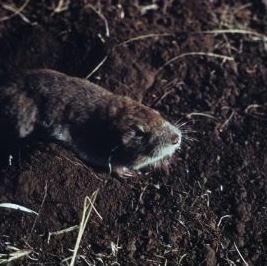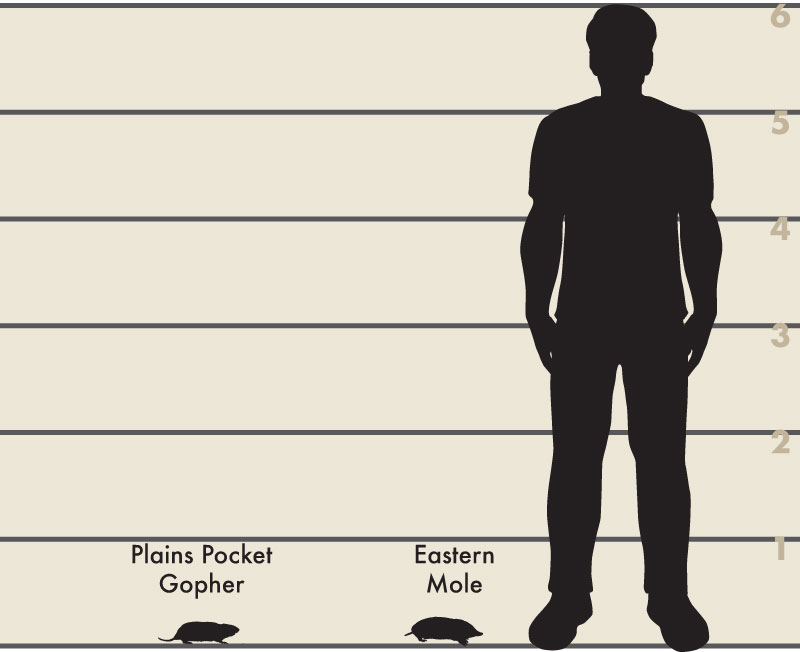
Photo: National Park Service, public domain
Pocket gopher tunneling behavior increases soil fertility and aeration and decreases soil compaction.
Plains pocket gophers belong to the Geomyidae family. They are approximately 8 to 123⁄4 inches in length, including the tail. Adults can weigh up to 1 pound; males are generally larger than females. Plains pocket gophers are larger than eastern moles. They have stocky bodies, small eyes and ears, and sparsely furred tails. They typically have black or dark brown fur with dark gray or brownish-colored undersides. The fur is soft, short, and dense. The tops of their feet and the end of the tail are white. Their front claws are long and strongly curved, while the back claws are short. Plains pocket gophers have external cheek pouches that are used to transport food and nesting materials.
Plains pocket gophers spend most of their lives underground, so their tracks and scat are seldom found. The best indicators of their presence in an area are the kidney- or fan-shaped mounds of soil they produce. These mounds are often one to two feet in diameter and may be up to one foot tall. Unlike molehills, pocket gopher mounds are not connected by surface tunnels, but the mounds are usually found in a line.
Plains pocket gophers are found throughout much of the midsection of Illinois. Their range extends from St. Clair and Madison counties to east and south of the Illinois River over to the Kankakee River and south of that river to the border of Indiana. They can be locally abundant. They prefer sandy soils.
Plains pocket gophers are solitary animals and will aggressively defend their burrow from other pocket gophers. They spend almost all of their time in their underground burrows. When excavating a burrow system, a pocket gopher can produce up to three mounds of soil a day.
Pocket gophers pose no public health concerns.
Plains pocket gophers need well-drained soils since they spend much of their lives in underground burrows. The burrows may be dug under roadsides, old fields, hayfields, cemeteries, golf courses, or lawns. Their burrow systems may be up to 500 feet long and are usually within three feet of the ground’s surface.
Plains pocket gophers are classified as herbivores. They feed mainly on roots, rhizomes, and bulbs. They are also known to consume roots of shrubs and small trees and the leaves of such plants as alfalfa, clover, sweet clover, bluegrass, dandelion, dock, and plantain.
Breeding takes place January through spring. Plains pocket gophers have one litter each year, with an average of three to four young per litter. The young gophers are cared for by the female only, and they are weaned by five to six weeks of age. After a few more weeks the young disperse to dig their own burrow systems. They typically live less than three years.
The tunneling and mound-producing behavior of pocket gophers can damage lawns. The mounds of soil may be considered unsightly in a manicured landscape.
Before beginning a control plan it is important to make sure that pocket gophers are causing the tunneling and mounds of soil. The eastern mole (Scalopus aquaticus) also occurs in Illinois and lives a subterranean life similar to the pocket gopher. Moles excavate circular, volcano-shaped mounds of soil typically 4 to 8 inches high. The pocket gopher excavates kidney-shaped mounds.
Pocket gophers are attracted to areas with a good supply of food in loamy or sandy soils. Packing the soil with a lawn roller may make the area less attractive to pocket gophers, but this technique can hinder turf growth.
It is possible to exclude pocket gophers from small areas by using a barrier made of hardware cloth. The wire must be buried at least 18 inches deep.
There no registered repellents for pocket gopher control in Illinois.
Frightening devices, such as ultrasonic emitters, have not proven to be effective against pocket gophers.
Grain baits treated with strychnine alkaloid (0.25 to 0.5% active ingredient) or zinc phosphide are sometimes used. These products are registered as Restricted Use Pesticides, and only licensed pesticide applicators may use the products. Baits should be placed in the burrow to reduce the likelihood of killing nontarget species.
Fumigants are typically ineffective and are not recommended for pocket gopher control.
Trapping is the recommended control method for pocket gophers. There are several products designed specifically for trapping gophers. A permit is not needed to trap pocket gophers. Following trap instructions will increase the success of this control method. The Internet Center for Wildlife Damage Control ha developed a detailed guide to trapping pocket gophers.
Keep in mind that removing one or more pocket gophers will open up the area to invasion from other pocket gophers. If the soil conditions are good and there is a food supply, pocket gophers will continue to use the area.
Pocket gophers are not protected by the Illinois Wildlife Code. A permit is not needed to remove them.

Photo: Paul Newbit

Illustrator: Lynn Smith
The Wildlife Illinois website was authorized by the Illinois Department of Natural Resources (IDNR) in partial fulfillment of project W-147-T. The website was developed by the National Great Rivers Research and Education Center, 2wav, and the IDNR in partnership with the United States Department of Agriculture Animal and Plant Health Inspection Service Wildlife Services and University of Illinois Extension to provide research-based information about how to coexist with Illinois wildlife.